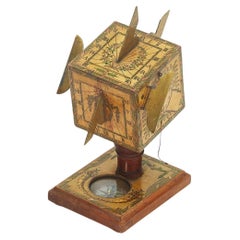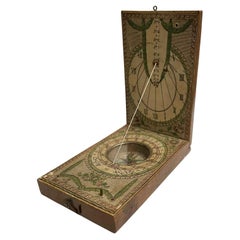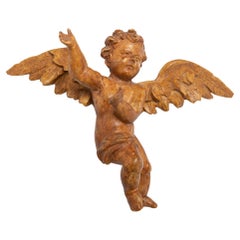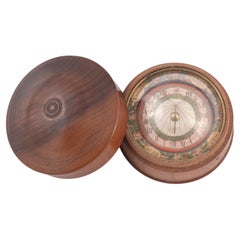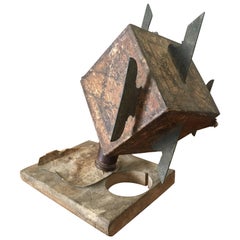David Beringer Furniture
2
to
2
2
2
2
1
2
2
1
1
1
1
2
2
1
5,177
4,015
2,457
2,235
Creator: David Beringer
David Beringer (1756-1821) Polyhedral Wooden Sundial
By David Beringer
Located in Firenze, IT
Shipping policy
No additional costs will be added to this order.
Shipping costs will be totally covered by the seller (customs duties included).
DAVID BERINGER (1756-1821)
The frui...
Category
Late 18th Century German Neoclassical Antique David Beringer Furniture
Materials
Wood
18th Century Diptych Portable Sundial And Compass by German Beringer
By David Beringer
Located in Milan, IT
Antique 18th Century Diptych Sundial and Compass a portable wooden boxwood sundial with compass, of German origin, by David Beringer, Nuremberg, dating back to the 1790 circa, in good age related condition, with signs of wear consistent with age and use.
David Beringer (1756 – 1821) was a German scientific instrument maker and craftsman active in Nuremberg and famous for his cubic wooden sundials visible in Metropolitan Museum of Art di New York.
A portable sundial...
Category
Late 18th Century German Antique David Beringer Furniture
Materials
Brass
Related Items
Italian Antique Wooden Angel
Located in Alessandria, Piemonte
Antique wooden angel from the mid 1800's, with traces of lacquer but no trace of gilding: I could gild it, but I prefer it as it is.
To hang anywhere You ...
Category
Mid-19th Century Italian Neoclassical Antique David Beringer Furniture
Materials
Wood
A Porter's Direction Sundial Germany Early 19th Century
Located in Firenze, IT
The printed and pivoted compass card and chapter ring centred by brass gnomon, in turned rosewood case with domed lid, (glass cover), 5cm (2in) diam.
Category
Early 19th Century German Neoclassical Antique David Beringer Furniture
Materials
Wood
Antique Cylinder Sundial Late 19th Century
Located in Firenze, IT
Shipping policy No additional costs will be added to this order. Shipping costs will be totally covered by the seller (customs duties included).
A boxwood cylinder sundial, also kn...
Category
Late 19th Century British Late Victorian Antique David Beringer Furniture
Materials
Wood, Paper
18th Century Altar Modell, South Germany, with Original Painting, Wood
Located in Epfach, DE
18th century Altar Modell, South Germany, with original painting, wood
A rare altar model with original painting, in the middle Jesus Christus and on the top God the father
and two...
Category
Late 18th Century German Louis XVI Antique David Beringer Furniture
Materials
Wood
H 22.05 in W 18.12 in D 2.76 in
German 18th Century Silver And Hardwood Snuff Box
Located in Copenhagen, K
Wonderful carved German or Austrian snuff box hunting motive and silver mounting. Carved to fit "hand in glove."
Provenance: Exhibited at the Dome M...
Category
Mid-18th Century German Baroque Antique David Beringer Furniture
Materials
Silver
18th Century German Pewter Passover Plate
Located in New York, NY
Pewter passover tray, Germany, 18th century.
The outer rim has wriggle- work engraving of the order of the Seder service, along with a pair of birds fl...
Category
Late 18th Century German Antique David Beringer Furniture
Materials
Pewter
Compass with Pocket Sundial, with Case, Bronze, Butterfield, Michael '1635-1724'
Located in Madrid, ES
Compass with pocket sundial, with case. Bronze. BUTTERFIELD, Michael (1635-1724). Paris, circa 1700.
Pocket sundial made of engraved metal, with a gno...
Category
Early 18th Century French Neoclassical Antique David Beringer Furniture
Materials
Metal, Bronze, Other
H 2.96 in W 3.35 in D 0.79 in
Silver Brass Pocket Sundial Compass French, circa 1780
Located in Firenze, IT
Shipping policy
No additional costs will be added to this order.
Shipping costs will be totally covered by the seller (customs duties included).
Silver brass octagonal dial with fo...
Category
Late 18th Century German Louis XVI Antique David Beringer Furniture
Materials
Silver, Brass
19th Century French Table Sundial And Compass
Located in Firenze, IT
Shipping policy
No additional costs will be added to this order.
Shipping costs will be totally covered by the seller (customs duties included).
Brass sundial with folding gnoman. ...
Category
Late 19th Century French Napoleon III Antique David Beringer Furniture
Materials
Brass
Large 17th Century French Slate Octagonal Sundial
Located in Madrid, ES
A Large 17th century French Slate Octagonal Sundial
With wrought iron gnomon and profusely engraved with latin letters.Size:39x39 cm.With latter hanging ...
Category
Mid-17th Century Antique David Beringer Furniture
Materials
Slate
Christ , 18th Century
Located in Saint-Ouen, FR
Christ , 18th century.
Crucifix, Christ, beautiful carved and gilded wood frame, 18th century.
Dimensions: H: 61cm, W: 39cm, D: 7cm.
Category
18th Century French Louis XVI Antique David Beringer Furniture
Materials
Wood
Mechanical Equatorial Sundial, Johann Michael Bergauer, Ante 1745
By Johann Michael Bergauer
Located in Milano, IT
Johann Michael Bergauer (Simonsfeld, 1676 - Innsbruck, 1745 circa)
Mechanical equatorial sundial
Signed: Michael Bergauer Insprugg? Innsbruck?
Ante 1745
Gilded and silvered brass; glass.
Measures: closed 1.29 x 3.50 x 4.92 in (33 x 89 x 125 mm); open 5.19 x 3.50 x 3.81 in (132 x 89 x 97 mm).
Weight: the sundial 0.49 lb (224 g); the case 0, 20 lb (95 g)
Original wooden case covered in brown leather.
State of conservation: very good. It has some signs of use. The spring that allowed for the two parts of the instrument to remain open is missing (absent even in the comparative specimens kept in museums).
The sundial is composed of two overlapping plates hinged together on the north edge.
The base plate is octagonal and is supported by three turned legs. The upper face is gilded and a compass with a magnetic variation index has been inserted. The rest of the surface is occupied by a rich decoration of engraved scrolls, centered around the inscription “Michael Bergauer Insprugg”. A foldable oval support with a plumb-bob is attached with a hinge on the southern edge. On the reverse of the base plate a table of the latitudes of some European cities (expanded with the vertical writing “Meiland 40” on the edge and “Rome” deleted) and of Jerusalem has been engraved. A Cam marked for 0 °-70 ° is applied near the northern edge. This can be adjusted to change the inclination of the upper plate according to the latitude; originally a spring, now lost, made it possible to keep the two plates of the clock open.
The second plate is round, has a toothed edge and measures 3.26 in (83 mm) in diameter: it is slightly smaller than the octagonal base which it rests upon and overlaps when the instrument is closed.
The recto is gilded and there are three concentric graduated circles engraved on it:
- the outermost is the equatorial hour dial, numbered I-XII, I-XII;
- the second-one is that of days 1-30 of the lunar month and has “Aetas lunae” engraved on it;
- the third, silvered, is a subsidiary hour dial, with double numbering 1-12; originally it could have been rotated.
The engravings of the first two circles are enameled in red.
In the center - on the polar axis - there is an alidade, at the end of which is associated the silvered minute dial. This, in turn, is welded, perpendicularly, to a small disc, also silvered, with a triangular gnomon. The plate, alidade and minute dial are connected to each other by toothed mechanisms.
Below is the procedure for measuring the time:
1) Adjust the Cam under the base of the clock, based on the latitude of your location;
2) Place the watch on a flat surface using the plumb-bob and with the side closest to the compass facing south;
3) Keeping the instrument still, manually rotate the alidade until the shadow cast by the triangular gnomon on the small silvered disc falls on the line marked below it;
4) The hour and minutes can therefore be read on the hour and minute dials set on the alidade respectively.
Johann Michael Bergauer, who sometimes only signs his works as Michael Bergauer, was born in Simonsfeld, north of Vienna. His apprenticeship as a watchmaker took place in Landshut and he probably worked as a laborer in Augsburg before becoming a watchmaker at the court of Karl Philipp von der Pfalz in Innsbruck in 1708. In the following years, his repeated attempts to obtain Innsbruck citizenship are documented and, in 1721, he is listed as a resident. In 1724 he was admitted to the guild of watchmakers, with which however he had continuous problems. In 1732 he presented a "masterpiece". This is the last reference to his business; he must have died before or in 1745 because in that year his widow appealed to the City Council.
The mechanical sundial...
Category
1730s Austrian Baroque Antique David Beringer Furniture
Materials
Brass
Previously Available Items
Sundial from the End of the 18th Century
By David Beringer
Located in Brooklyn, NY
Polyhedral sundial in wood covered with prints
Signed D Beringer, Nuremberg.
Category
Late 18th Century German Louis XVI Antique David Beringer Furniture
Materials
Steel
David Beringer furniture for sale on 1stDibs.
David Beringer furniture are available for sale on 1stDibs. These distinctive items are frequently made of wood and are designed with extraordinary care. There are many options to choose from in our collection of David Beringer furniture, although brown editions of this piece are particularly popular. If you’re looking for additional options, many customers also consider furniture by Somso, Homann Heirs, and Matthäus Merian the Elder. Prices for David Beringer furniture can differ depending upon size, time period and other attributes — on 1stDibs, these items begin at $1,221 and can go as high as $1,221, while a piece like these, on average, fetch $1,221.
